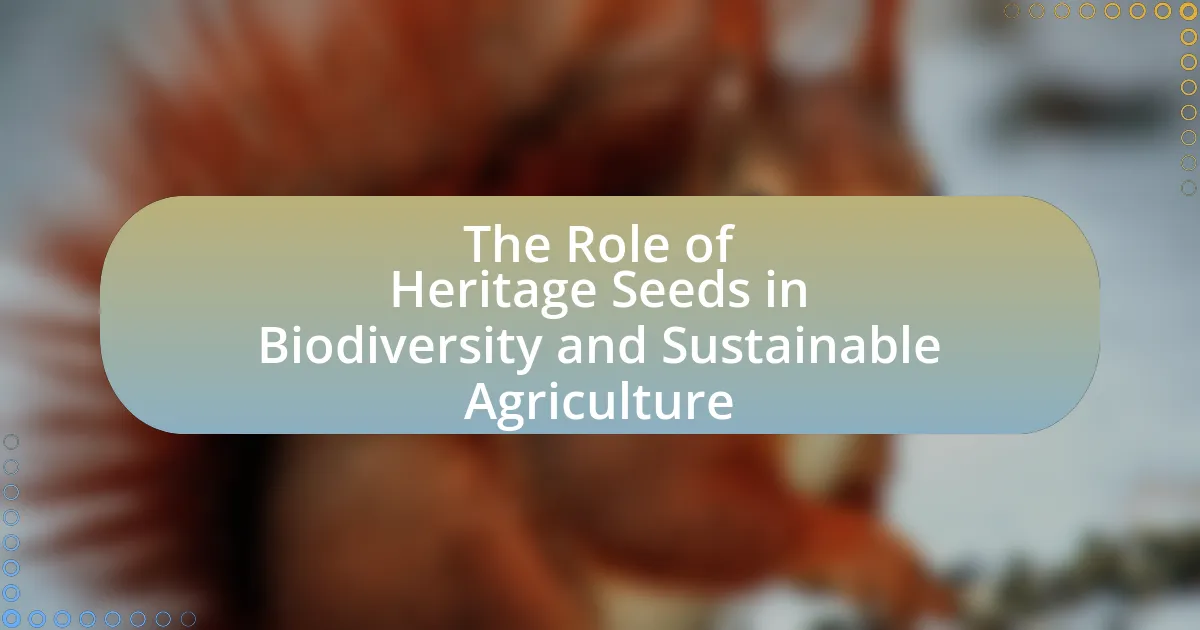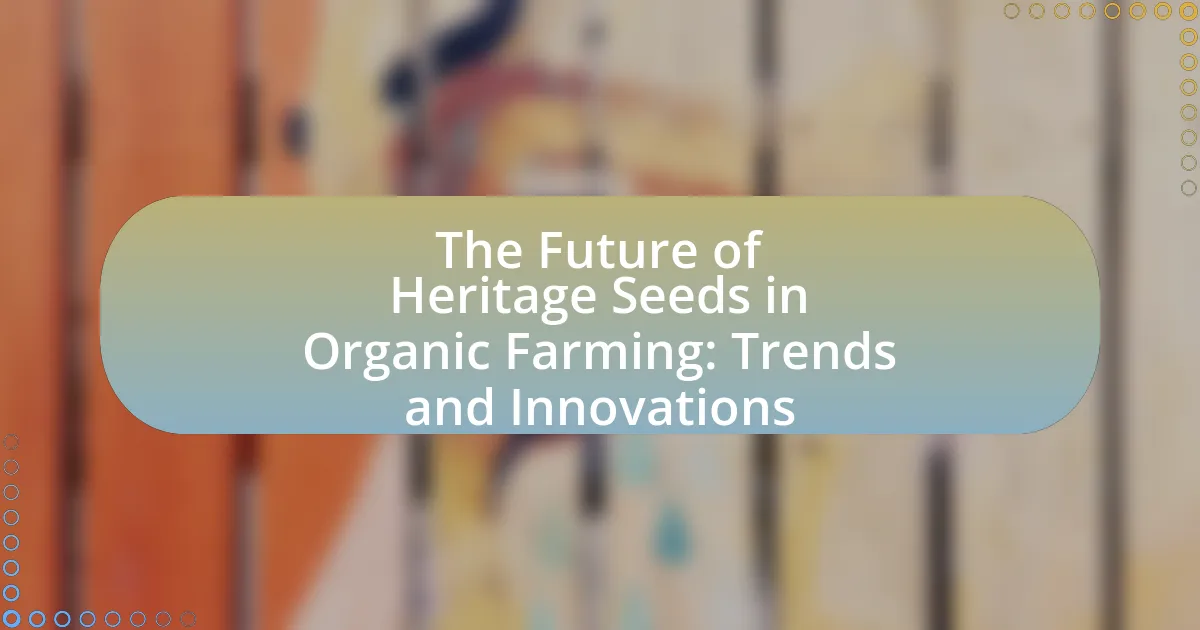The article focuses on best practices for seed saving, emphasizing the importance of preserving heritage seeds for future generations. Key practices include selecting healthy seeds, ensuring proper isolation to prevent cross-pollination, and storing seeds in optimal conditions to maintain viability. The article discusses the significance of seed saving for biodiversity, food security, and sustainable agriculture, highlighting the role of heritage seeds in maintaining genetic diversity. It also outlines practical steps for seed saving, common challenges faced, and resources available for seed savers, providing a comprehensive guide for individuals interested in preserving heirloom varieties.
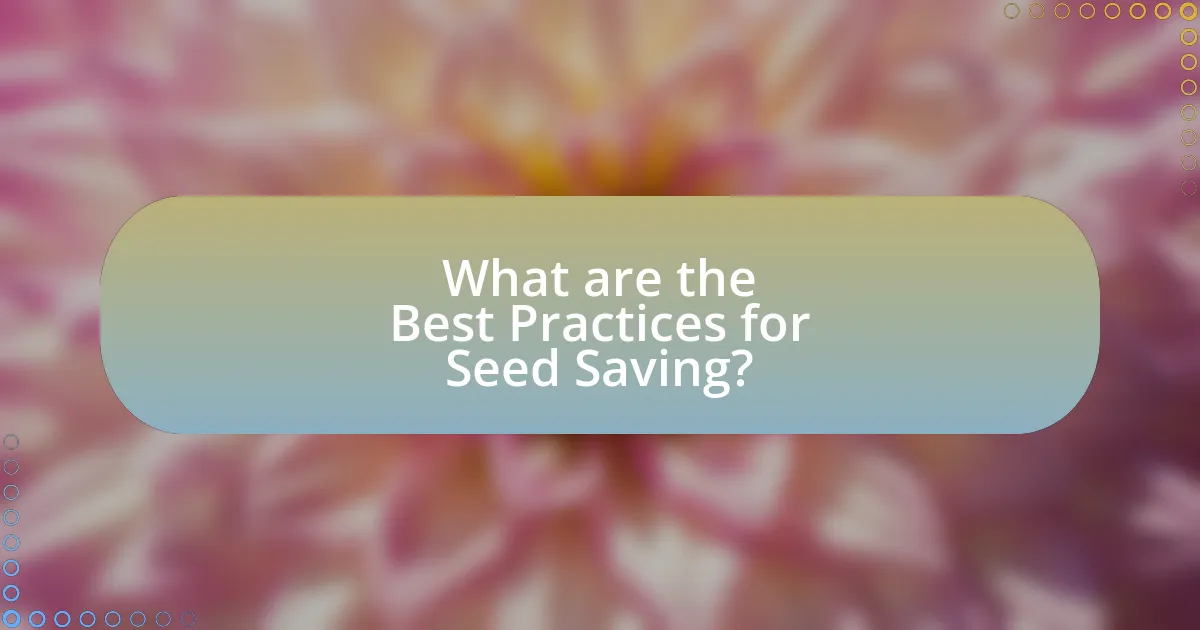
What are the Best Practices for Seed Saving?
The best practices for seed saving include selecting healthy, mature seeds from the best plants, ensuring proper isolation to prevent cross-pollination, and storing seeds in a cool, dry place. Healthy seeds are crucial as they increase the likelihood of successful germination and robust plants. Isolation methods, such as physical barriers or timing of planting, help maintain the genetic integrity of the seeds. Additionally, storing seeds in airtight containers in a refrigerator or a cool, dark location can significantly extend their viability, with some seeds lasting for decades when stored properly. These practices are supported by agricultural studies that emphasize the importance of genetic diversity and seed quality in sustainable farming.
Why is Seed Saving Important for Heritage Seeds?
Seed saving is crucial for heritage seeds because it ensures the preservation of genetic diversity and cultural heritage. Heritage seeds, often heirloom varieties, are adapted to local conditions and carry unique traits that may be lost if not saved. By saving seeds, farmers and gardeners maintain these varieties, which can contribute to food security and resilience against pests and diseases. Historical data shows that many heirloom varieties have been lost due to industrial agriculture practices; for instance, the USDA estimates that 93% of seed varieties available in 1903 are now extinct. Therefore, seed saving acts as a safeguard against biodiversity loss and promotes sustainable agricultural practices.
What role do heritage seeds play in biodiversity?
Heritage seeds play a crucial role in biodiversity by preserving genetic diversity within plant species. These seeds, often heirloom varieties, maintain traits that have adapted to local environments over generations, contributing to ecosystem resilience. For instance, heritage seeds can withstand specific pests and diseases better than modern hybrids, which often lack such genetic variation. This genetic diversity is essential for food security, as it allows for a wider range of crops that can adapt to changing climate conditions and agricultural challenges. Studies have shown that maintaining diverse seed stocks can enhance agricultural productivity and sustainability, highlighting the importance of heritage seeds in promoting biodiversity.
How does seed saving contribute to sustainable agriculture?
Seed saving contributes to sustainable agriculture by preserving genetic diversity and reducing dependency on commercial seed sources. This practice allows farmers to select seeds from the best-performing plants, ensuring that crops are well-adapted to local conditions and resilient to pests and diseases. According to the Food and Agriculture Organization, maintaining diverse seed varieties enhances ecosystem stability and food security, as it enables farmers to respond to changing environmental conditions and market demands. Additionally, seed saving fosters self-sufficiency, as farmers can produce their own seeds, decreasing reliance on external inputs and promoting economic sustainability.
What are the Basic Steps in Seed Saving?
The basic steps in seed saving include selecting healthy plants, allowing seeds to mature fully, harvesting seeds at the right time, cleaning and drying seeds, and storing them in a cool, dark place. Selecting healthy plants ensures that the seeds will produce strong offspring. Allowing seeds to mature fully is crucial, as immature seeds may not germinate properly. Harvesting seeds at the right time, typically when they are dry and fully developed, maximizes viability. Cleaning and drying seeds prevents mold and decay, while proper storage conditions help maintain seed longevity. These practices are essential for preserving heritage seeds for future generations.
How do you select the right seeds for saving?
To select the right seeds for saving, choose seeds from healthy, vigorous plants that exhibit desirable traits such as disease resistance, high yield, and adaptability to local conditions. This selection process ensures that the saved seeds will produce robust offspring that maintain the qualities of the parent plants. Research indicates that seeds from open-pollinated varieties are preferable, as they will reliably produce plants similar to the parent, unlike hybrid seeds which may not retain the desired characteristics in subsequent generations.
What methods are used for harvesting seeds?
Methods used for harvesting seeds include hand-picking, mechanical harvesting, and threshing. Hand-picking involves manually collecting seeds from plants, ensuring that only mature seeds are selected, which is common for small-scale or specialty crops. Mechanical harvesting utilizes machines to efficiently gather seeds from larger fields, significantly increasing the speed and volume of seed collection. Threshing separates seeds from the plant material after harvesting, which can be done manually or with machines, ensuring that seeds are clean and ready for storage. These methods are essential for effective seed saving and preservation of heritage seeds, as they help maintain seed quality and viability for future generations.
What Challenges are Associated with Seed Saving?
Seed saving faces several challenges, including genetic degradation, cross-pollination, and legal restrictions. Genetic degradation occurs when seeds are saved over multiple generations without proper selection, leading to reduced vigor and adaptability. Cross-pollination can result in unintended hybridization, compromising the purity of heirloom varieties. Additionally, legal restrictions, such as seed patenting and regulations on seed exchange, can hinder the ability of individuals to save and share seeds. These challenges necessitate careful management and knowledge to ensure the preservation of heritage seeds for future generations.
How can cross-pollination affect seed purity?
Cross-pollination can significantly reduce seed purity by introducing genetic material from different plant varieties, leading to hybridization. When pollen from one plant fertilizes the ovules of another, the resulting seeds may carry traits from both parent plants, which can alter the expected characteristics of the heritage seeds. Research indicates that cross-pollination can occur even over considerable distances, depending on the plant species and environmental factors, thereby increasing the risk of unintended genetic mixing. For instance, studies have shown that corn can cross-pollinate with neighboring varieties up to a distance of 1,600 feet, which can compromise the purity of seed stocks intended for preservation.
What are the common pests and diseases that threaten saved seeds?
Common pests that threaten saved seeds include aphids, weevils, and seed corn maggots, while diseases such as seed-borne fungi, bacterial blights, and viruses also pose significant risks. Aphids can damage seeds by feeding on plant sap, leading to reduced vigor, while weevils can infest seeds, causing physical damage and loss of viability. Seed-borne fungi, like Fusarium and Aspergillus, can contaminate seeds, leading to poor germination rates and plant health issues. Bacterial blights can spread through infected seeds, resulting in crop failures, and viruses can be transmitted via seeds, affecting plant growth and yield. These threats highlight the importance of proper seed storage and handling practices to ensure seed viability and health.
How can Seed Saving Practices be Improved?
Seed saving practices can be improved by implementing standardized protocols for seed selection, storage, and documentation. Standardized protocols ensure that seeds are chosen based on traits such as disease resistance and adaptability to local conditions, which enhances the quality and viability of saved seeds. Research indicates that proper storage conditions, including temperature and humidity control, significantly increase seed longevity and germination rates. Additionally, thorough documentation of seed origins and growing conditions aids in maintaining genetic diversity and allows for better tracking of seed performance over time.
What Resources are Available for Seed Savers?
Seed savers have access to a variety of resources, including seed banks, educational workshops, and online communities. Seed banks, such as the Seed Savers Exchange, provide a repository for heirloom seeds and offer guidance on seed saving techniques. Educational workshops, often hosted by local agricultural organizations or universities, teach best practices for preserving seed diversity. Online communities, like forums and social media groups, facilitate knowledge sharing among seed savers, allowing them to exchange tips and experiences. These resources collectively support the preservation of heritage seeds for future generations.
Where can you find seed saving organizations and networks?
Seed saving organizations and networks can be found through various platforms, including the Seed Savers Exchange, which connects individuals interested in preserving heirloom seeds. Additionally, local agricultural extension offices often provide resources and contacts for regional seed saving groups. The USDA also lists community seed banks and organizations dedicated to seed preservation. These entities play a crucial role in maintaining biodiversity and supporting sustainable agriculture practices.
What literature and guides are recommended for beginners?
For beginners interested in seed saving and preserving heritage seeds, “Seed to Seed” by Suzanne Ashworth is highly recommended as it provides comprehensive guidance on seed saving techniques for various plant species. Additionally, “The Seed Garden: The Art and Practice of Seed Saving” by Jared Zystro and Erin M. M. L. O’Neill offers practical advice and detailed instructions tailored for novice seed savers. These texts are widely recognized in the gardening community for their clarity and depth, making them essential resources for anyone starting in this field.
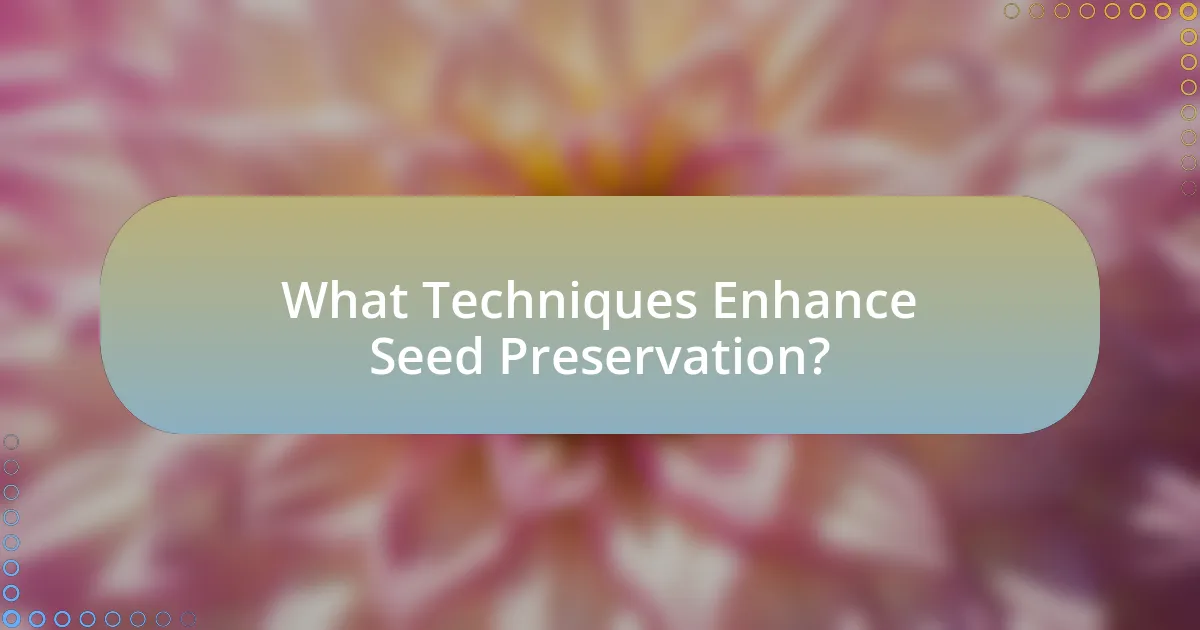
What Techniques Enhance Seed Preservation?
Techniques that enhance seed preservation include proper drying, storage in cool and dark environments, and using airtight containers. Proper drying reduces moisture content, which is crucial as seeds with high moisture levels are more susceptible to mold and decay. Storing seeds in cool, dark places slows down metabolic processes and extends viability; for instance, temperatures below 50°F (10°C) are often recommended. Airtight containers prevent moisture and pests from compromising seed integrity, ensuring longer shelf life. These methods are supported by research indicating that optimal storage conditions can significantly increase seed longevity, with some seeds remaining viable for decades under ideal circumstances.
How do Different Storage Methods Impact Seed Longevity?
Different storage methods significantly impact seed longevity by influencing factors such as moisture, temperature, and light exposure. For instance, seeds stored in cool, dry, and dark conditions can remain viable for several years, while those kept in warm, humid environments may lose viability within months. Research indicates that seeds stored at temperatures below 10°C and with moisture content below 5% can maintain their germination rates for decades, as demonstrated in studies by the Seed Savers Exchange. Conversely, seeds stored in plastic bags at room temperature can deteriorate rapidly due to increased moisture and temperature fluctuations, leading to reduced longevity.
What are the best practices for drying seeds?
The best practices for drying seeds include ensuring proper air circulation, maintaining low humidity, and using a clean, dry environment. To effectively dry seeds, spread them out in a single layer on a clean surface, such as a screen or paper towel, to allow for even airflow. It is crucial to keep the drying area at a temperature between 70°F and 90°F (21°C to 32°C) to prevent mold growth. Additionally, seeds should be checked regularly for moisture content; they are adequately dried when they feel hard and snap rather than bend. These practices are supported by agricultural guidelines that emphasize the importance of preventing moisture to enhance seed viability and longevity.
How does temperature and humidity affect seed storage?
Temperature and humidity significantly impact seed storage by influencing seed viability and longevity. High temperatures can accelerate seed aging and reduce germination rates, while excessive humidity can lead to mold growth and seed deterioration. Research indicates that seeds stored at lower temperatures (around 5°C) and low humidity (below 20% relative humidity) can maintain viability for extended periods, often exceeding several years. Conversely, seeds stored in warm and humid conditions may lose viability within months, highlighting the importance of controlled storage environments for preserving heritage seeds effectively.
What are the Best Practices for Labeling and Organizing Saved Seeds?
The best practices for labeling and organizing saved seeds include using clear, waterproof labels and maintaining a detailed inventory system. Clear labels should include the seed variety, date of harvest, and any specific growing conditions, ensuring that essential information is easily accessible. A detailed inventory system, whether digital or physical, helps track seed quantities and germination rates, facilitating better planning for future planting seasons. Research indicates that proper labeling and organization can significantly enhance seed viability and ease of access, ultimately supporting sustainable gardening practices.
How can proper labeling prevent mix-ups in seed varieties?
Proper labeling prevents mix-ups in seed varieties by ensuring clear identification of each seed type, which minimizes the risk of cross-contamination and misplanting. Accurate labels provide essential information such as the variety name, planting date, and specific growing conditions, which helps gardeners and farmers maintain the integrity of each seed type. Studies have shown that mislabeled seeds can lead to significant crop losses; for instance, a 2018 report by the American Seed Trade Association indicated that improper labeling contributed to a 15% decrease in yield for affected farmers. Therefore, effective labeling practices are crucial for preserving the distinct characteristics of heritage seeds and ensuring successful cultivation.
What systems can be used for organizing seeds effectively?
Effective systems for organizing seeds include labeled seed packets, seed storage bins, and digital inventory management tools. Labeled seed packets allow for easy identification of seed varieties, while seed storage bins can be categorized by plant type or growing season to enhance organization. Digital inventory management tools, such as apps or spreadsheets, enable gardeners to track seed quantities, germination rates, and planting dates, facilitating better planning and usage. These methods are widely adopted by gardeners and agriculturalists to ensure efficient seed management and preservation of heritage seeds.
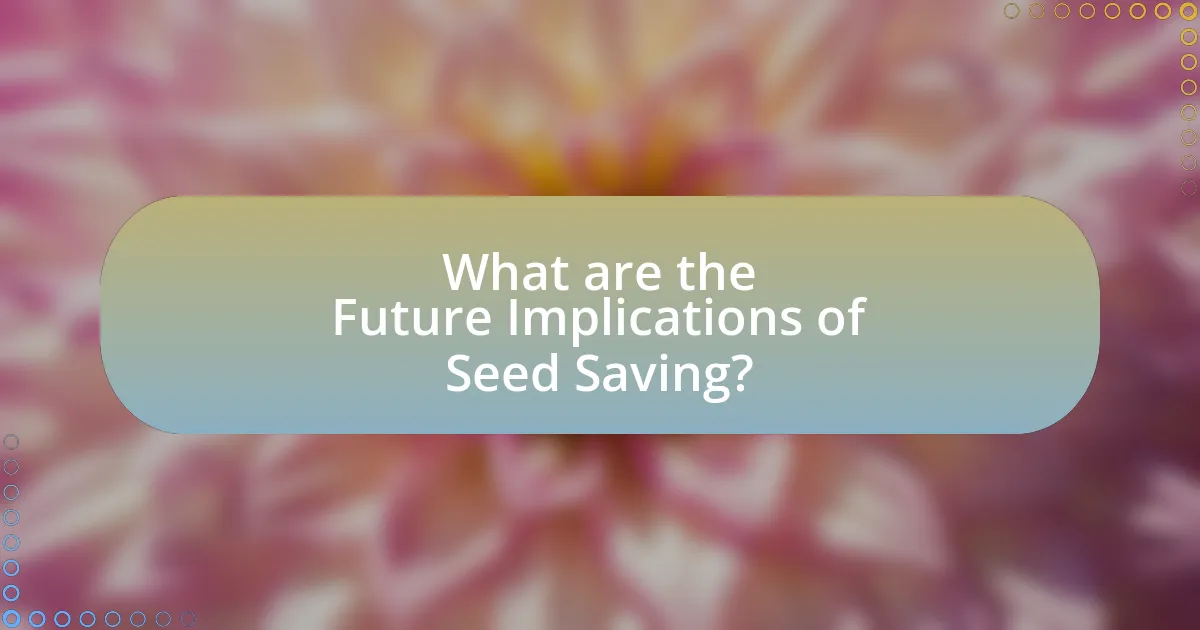
What are the Future Implications of Seed Saving?
The future implications of seed saving include enhanced biodiversity, improved food security, and the preservation of heritage varieties. By maintaining a diverse gene pool, seed saving practices contribute to ecosystem resilience, allowing crops to adapt to changing environmental conditions. Furthermore, as global populations grow, seed saving can help ensure a stable food supply by enabling local communities to cultivate crops suited to their specific climates and soils. Historical evidence shows that traditional seed saving has led to the preservation of thousands of plant varieties, which are crucial for sustainable agriculture and nutrition.
How does Seed Saving Contribute to Food Security?
Seed saving contributes to food security by ensuring the availability of diverse and resilient crop varieties. This practice allows farmers to maintain genetic diversity, which is crucial for adapting to changing environmental conditions and pests. For instance, a study by the Food and Agriculture Organization (FAO) highlights that preserving local seed varieties can enhance agricultural resilience, thereby supporting food systems in the face of climate change. Additionally, seed saving reduces dependency on commercial seed markets, which can be volatile and inaccessible for smallholder farmers, further stabilizing food production and availability.
What impact does seed saving have on local food systems?
Seed saving significantly enhances local food systems by promoting biodiversity and resilience. By preserving a variety of seeds, communities can maintain a diverse gene pool that supports local agriculture, adapts to changing environmental conditions, and reduces dependency on commercial seed suppliers. Research indicates that diverse crop varieties can lead to improved yields and better pest resistance, which is crucial for food security. For instance, a study published in the journal “Agriculture, Ecosystems & Environment” found that farms practicing seed saving had a 20% increase in crop resilience compared to those relying solely on commercial seeds. This practice not only sustains local food production but also fosters community engagement and knowledge sharing, further strengthening local food networks.
How can seed saving practices be integrated into community initiatives?
Seed saving practices can be integrated into community initiatives by establishing local seed banks and organizing educational workshops. Local seed banks serve as repositories for diverse seed varieties, promoting biodiversity and resilience in local agriculture. Educational workshops can teach community members about the importance of seed saving, techniques for proper seed storage, and the benefits of preserving heritage seeds. Research indicates that community-based seed saving initiatives enhance food security and foster sustainable agricultural practices, as evidenced by successful programs in regions like the Andes, where local farmers have maintained traditional seed varieties through collective efforts.
What Practical Tips Can Help Beginners in Seed Saving?
To effectively save seeds, beginners should start by selecting healthy, mature plants from which to collect seeds. This ensures that the seeds are viable and genetically strong. Additionally, it is crucial to allow seeds to fully ripen on the plant before harvesting, as immature seeds may not germinate properly. Beginners should also label and store seeds in a cool, dry place to maintain their viability over time. Research indicates that seeds stored in optimal conditions can remain viable for several years, with some even lasting decades. Following these practices will help ensure successful seed saving for future planting.
What are the first steps to start saving seeds at home?
To start saving seeds at home, first select healthy, mature plants from which to collect seeds. This ensures that the seeds will have the best chance of germinating and producing strong plants in the future. Next, allow the seeds to fully ripen on the plant before harvesting, as immature seeds may not be viable. After harvesting, clean the seeds to remove any plant material and dry them thoroughly to prevent mold during storage. Finally, store the seeds in a cool, dark, and dry place in labeled containers to maintain their viability for future planting.
How can you troubleshoot common seed saving issues?
To troubleshoot common seed saving issues, first identify the specific problem, such as low germination rates, seed rot, or pest infestations. For low germination rates, ensure seeds are harvested at the right time and stored in optimal conditions, as seeds stored in damp or warm environments can lose viability. Seed rot can be addressed by ensuring proper drying before storage and using breathable containers to prevent moisture buildup. Pest infestations can be mitigated by inspecting seeds regularly and using natural pest deterrents, such as diatomaceous earth, to protect stored seeds. These methods are supported by research indicating that proper seed storage conditions significantly enhance seed longevity and germination success.



